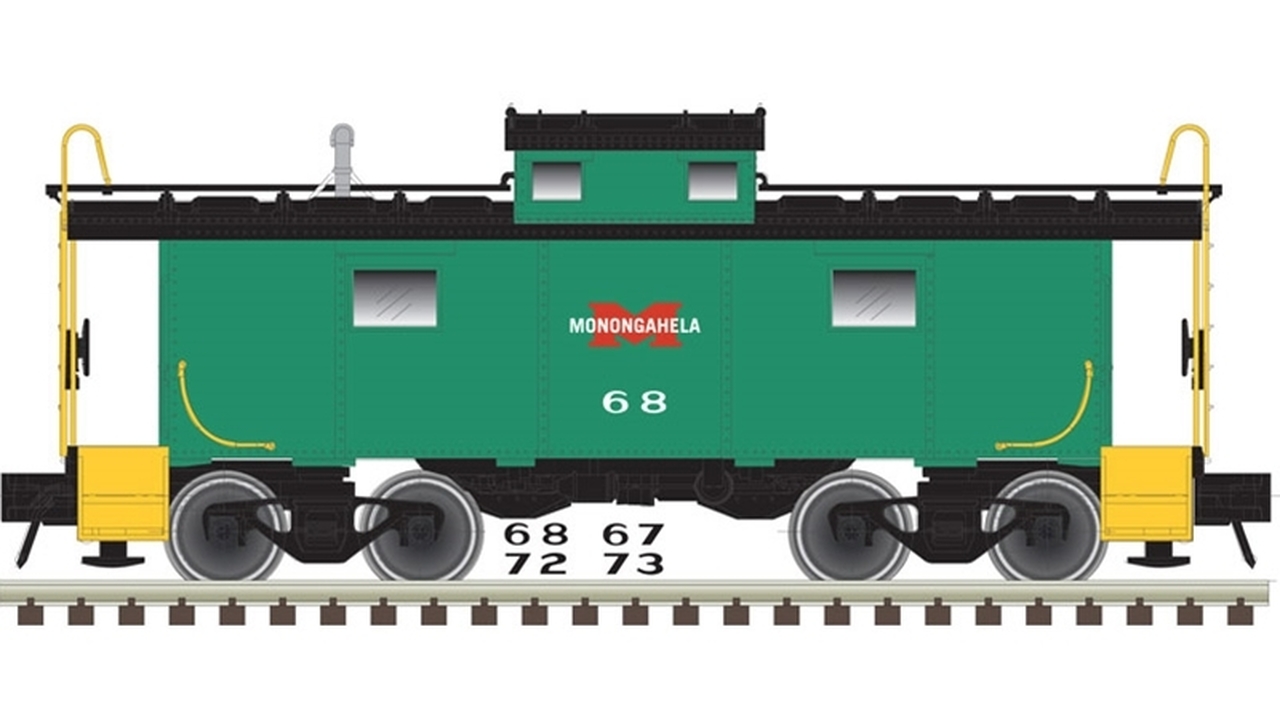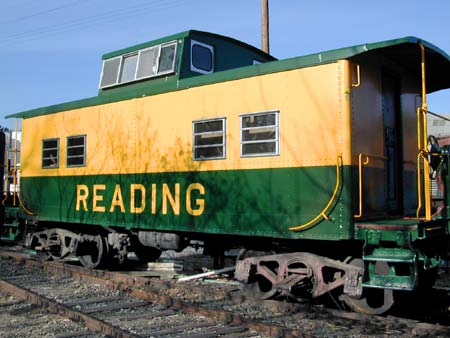Model Information: (Special Note: some of the pictures from Atlas appear to be of one of their larger-scale models - HO or O). This caboose model was introduced in 2004 and was a major step forward in quality from the earlier caboose models. Because of the initial product numbering convention, these models are known as "33" series. They show a higher level of detailing than earlier caboose body styles as can bee seen in the roofwalk, ladders and underframe. They also feature body-mount couplers.
At first glance these models seem very similar to the "39" series C&O cabooses from Atlas. The cupola may be found in the center of the body, and they feature two windows on each side supplemented by two separated windows on each side of the cupola. To distinguish the NE-6 from the "39" series C&O cabooses, you can see that the NE-6's are shorter and the NE-6 cupola has three panels on the cupola roof. Furthermore the cupola on the NE-6 is more squat than the one on the C&O.
The models feature: Finely detailed end rails, smokestack and ladders Brake line detail; Weighted chassis; Friction-bearing or roller-bearing caboose trucks as appropriate; Factory-equipped with AccuMate couplers; Accurate painting and printing; Railroad specific features
They are based on a standard caboose design of the International Car Company of Kenton, Ohio that was used in the 1940s. They are typically associated with the New Haven Railroad but this body style was in fact used by other rail lines as well. The cabooses showed real longevity and were found in operation well into the diesel era.
Two different body styles are available. The New Haven Body Style has windows spaced closer to the cupola, while the Nickel Plate Body Style has windows spaced further from the cupola.
At first glance these models seem very similar to the "39" series C&O cabooses from Atlas. The cupola may be found in the center of the body, and they feature two windows on each side supplemented by two separated windows on each side of the cupola. To distinguish the NE-6 from the "39" series C&O cabooses, you can see that the NE-6's are shorter and the NE-6 cupola has three panels on the cupola roof. Furthermore the cupola on the NE-6 is more squat than the one on the C&O.
The models feature: Finely detailed end rails, smokestack and ladders Brake line detail; Weighted chassis; Friction-bearing or roller-bearing caboose trucks as appropriate; Factory-equipped with AccuMate couplers; Accurate painting and printing; Railroad specific features
They are based on a standard caboose design of the International Car Company of Kenton, Ohio that was used in the 1940s. They are typically associated with the New Haven Railroad but this body style was in fact used by other rail lines as well. The cabooses showed real longevity and were found in operation well into the diesel era.
Two different body styles are available. The New Haven Body Style has windows spaced closer to the cupola, while the Nickel Plate Body Style has windows spaced further from the cupola.
Prototype History: The Northeast or NE style caboose was introduced by the Reading Railroad in 1924. The design was an all-steel version of a USRA design. The acquisition of these new cabooses was prompted by proposed Pennsylvania legislation requiring larger, more structurally sound caboose for use in through freight consists. The original set of cabooses was ordered from AC&F, but other manufacturers also adopted similar designs.
The Reading selection was made after the consideration of several designs. The original purchase was for 10 cars in 1924, but the design was so effective that it became the de-facto Reading standard and they continued purchasing new cabooses of this type through 1948. The design soon became popular with other Northeastern railroads such as the WM, L&NE, LV, CNJ and others.
The Reading selection was made after the consideration of several designs. The original purchase was for 10 cars in 1924, but the design was so effective that it became the de-facto Reading standard and they continued purchasing new cabooses of this type through 1948. The design soon became popular with other Northeastern railroads such as the WM, L&NE, LV, CNJ and others.
Road Name History: Monongahela (reporting marks MGA, although their logos showed MRY until the 1970s) began around 1901 as a joint venture between Pennsylvania Railroad and Pittsburg & Lake Erie to serve a coal producing region along the Pennsylvania – West Virginia border south of Brownsville, PA. Much of the line followed its namesake river. The size of the line changed constantly as nearby shortlines were acquired, coal branches were abandoned and new ones were built. The last major addition was the Waynesburg Southern built in 1968. Mileage for the MGA system hovered around 140 miles for most of its history. They interchanged with PRR, P&LE subsidiary Pittsburgh McKeesport & Youghiogheny in Pennsylvania and with B&O in West Virginia. B&O bought a 1/3 interest in the MGA in 1927.
In the early years, more coke was hauled than coal as dozens of coke oven operations were located on the line. Monongahela did have passenger service linking the mountain communities along the line but this service ended in 1950.
The early steam fleet consisted mostly of 2-8-0’s acquired second hand from PRR and P&LE along with 4-4-0’s for passenger service. Later 2-8-0 and 2-8-2’s were built new following PRR designs. Ex-P&LE Mikes also joined the roster. The 4-4-0’s were replaced by PRR design Atlantics. The last steamer was retired in 1954.
Steam power was replaced with an all-Baldwin diesel fleet. Over several years. MGA acquired 27 S12 switchers. In 1968, they received seven RF-16 shark nose A units and two B units from P&LE parent New York Central. Like the S12’s these were painted black and kept their NYC cigar band nose stripes with the oval MRY logo added to the nose. The 1970s and 80s brought five GP38’s and nine GP7’s (long-hood-forward) to replace the Baldwins. Beginning in 1990, they received eleven B-23-7R’s from GE Capital. These were Super-7’s with the “techno-toaster” body. They arrived in a version of GE Capital’s grey “shark” scheme. Rather than repaint them black, MGA adopted the scheme adding their big red M logo and name to the nose and flanks. In May of 1993, Monongahela Railway was merged into Conrail.
In the early years, more coke was hauled than coal as dozens of coke oven operations were located on the line. Monongahela did have passenger service linking the mountain communities along the line but this service ended in 1950.
The early steam fleet consisted mostly of 2-8-0’s acquired second hand from PRR and P&LE along with 4-4-0’s for passenger service. Later 2-8-0 and 2-8-2’s were built new following PRR designs. Ex-P&LE Mikes also joined the roster. The 4-4-0’s were replaced by PRR design Atlantics. The last steamer was retired in 1954.
Steam power was replaced with an all-Baldwin diesel fleet. Over several years. MGA acquired 27 S12 switchers. In 1968, they received seven RF-16 shark nose A units and two B units from P&LE parent New York Central. Like the S12’s these were painted black and kept their NYC cigar band nose stripes with the oval MRY logo added to the nose. The 1970s and 80s brought five GP38’s and nine GP7’s (long-hood-forward) to replace the Baldwins. Beginning in 1990, they received eleven B-23-7R’s from GE Capital. These were Super-7’s with the “techno-toaster” body. They arrived in a version of GE Capital’s grey “shark” scheme. Rather than repaint them black, MGA adopted the scheme adding their big red M logo and name to the nose and flanks. In May of 1993, Monongahela Railway was merged into Conrail.
Brand/Importer Information: In 1924 Stephan Schaffan, Sr. founded the Atlas Tool Company in Newark, New Jersey. In 1933 his son, Stephan Schaffan, Jr., came to work for his father at the age of sixteen. Steve Jr. built model airplanes as a hobby and frequented a local hobby shop. Being an enterprising young man, he would often ask the owner if there was anything he could do to earn some extra spending money. Tired of listening to his requests, the hobby-store owner threw some model railroad track parts his way and said, "Here, see if you can improve on this".
In those days, railroad modelers had to assemble and build everything from scratch. Steve Jr. created a "switch kit" which sold so well, that the entire family worked on them in the basement at night, while doing business as usual in the machine shop during the day.
Subsequently, Steve Jr. engineered the stapling of rail to fiber track, along with inventing the first practical rail joiner and pre-assembled turnouts and flexible track. All of these products, and more, helped to popularize model railroading and assisted in the creation of a mass-market hobby. The budding entrepreneur quickly outgrew the limitations of a basement and small garage operation. Realizing they could actually make a living selling track and related products, Steve and his father had the first factory built in Hillside, New Jersey at 413 Florence Avenue in 1947. On September 30, 1949, the Atlas Tool Company was officially incorporated as a New Jersey company.
In 1985, Steve was honored posthumously for his inventions by the Model Railroad Industry Association and was inducted into the Model Railroad Industry Hall of Fame in Baltimore, Maryland. In addition, Steve was nominated and entered into the National Model Railroad Association Pioneers of Model Railroading in 1995.
In the early 1990s, the Atlas Tool Company changed its name to Atlas Model Railroad Company, Inc.
In those days, railroad modelers had to assemble and build everything from scratch. Steve Jr. created a "switch kit" which sold so well, that the entire family worked on them in the basement at night, while doing business as usual in the machine shop during the day.
Subsequently, Steve Jr. engineered the stapling of rail to fiber track, along with inventing the first practical rail joiner and pre-assembled turnouts and flexible track. All of these products, and more, helped to popularize model railroading and assisted in the creation of a mass-market hobby. The budding entrepreneur quickly outgrew the limitations of a basement and small garage operation. Realizing they could actually make a living selling track and related products, Steve and his father had the first factory built in Hillside, New Jersey at 413 Florence Avenue in 1947. On September 30, 1949, the Atlas Tool Company was officially incorporated as a New Jersey company.
In 1985, Steve was honored posthumously for his inventions by the Model Railroad Industry Association and was inducted into the Model Railroad Industry Hall of Fame in Baltimore, Maryland. In addition, Steve was nominated and entered into the National Model Railroad Association Pioneers of Model Railroading in 1995.
In the early 1990s, the Atlas Tool Company changed its name to Atlas Model Railroad Company, Inc.
Item created by: Jenna on 2018-09-11 15:20:49
If you see errors or missing data in this entry, please feel free to log in and edit it. Anyone with a Gmail account can log in instantly.
If you see errors or missing data in this entry, please feel free to log in and edit it. Anyone with a Gmail account can log in instantly.











